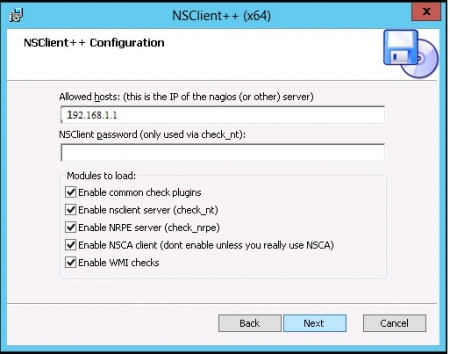NSClient++ is a windows service open source program, also called NSCP its an monitoring agent that allows easier to gathered by nagios. This post describe how to monitoring windows services from Nagios. Nagios server installed in Linux operating system and monitoring a windows server.
How to Install :
Download the latest Nagios NSClient++ package from the link.Now setup the nsclinet++ 64 bit version,
Click on " Next " button

Now, enter your Nagios server IP Address and ensure that " Modules to load ", Click on " Next "

Install nsclinet.ini configue file, click on " Next ".

Now installing in your server,

Finally click on " Finish " button,

If you need any changes can update in nsclient.ini file, its located in C:\Program Files\NSClient++
How to Configure in Nagios Server:
Open localhost.cfg and add the below line,
# vim /usr/local/nagios/etc/objects/localhost.cfg
#####Members######
define hostgroup{
hostgroup_name Windows-Servers
alias Windows-Servers
members host.domainname.com
}
Create a .cfg file for windows on same directory and add the below lines,
# vim /usr/local/nagios/etc/object/host.domainname.cfg
define host{
use Windows-Server
host_name host.domainname.com
alias domain
address 192.168.1.10 #Windows Server IP Address
}
define service{
use generic-service
host_name host.domainname.com
service_description NSClient++ Version
check_command check_nt!CLIENTVERSION
}
define service{
use generic-service
host_name host.domainname.com
service_description Uptime #Uptimes
check_command check_nt!UPTIME
}
define service{
use generic-service
host_name host.domainname.com
service_description CPU Load
check_command check_nt!CPULOAD!-l 5,80,90 #Looking CPU usage
}
define service{
use generic-service
host_name host.domainname.com
service_description Memory Usage
check_command check_nt!MEMUSE!-w 85 -c 90 #Looking Memory Usage
}
define service{
use generic-service
host_name host.domainname.com
service_description C:\ Drive Space
check_command check_nt!USEDDISKSPACE!-l c -w 85 -c 90 # Looking disk space C: dirve
}
define service{
use generic-service
host_name host.domainname.com
service_description D:\ Drive Space
check_command check_nt!USEDDISKSPACE!-l d -w 85 -c 90 # Looking disk space D: drive
}
define service{
use generic-service
host_name host.domainname.com
service_description W3SVC
check_command check_nt!SERVICESTATE!-d SHOWALL -l W3SVC
}
Error :
Free disk space : Invalid drive
Solution :
If the above error message showing on Nagios monitoring check your partition name (C:, D:, E:) in Nagios.
define service{
use generic-service
host_name host2.dnsrain.com
service_description D:\ Drive Space
check_command check_nt!USEDDISKSPACE!-l d -w 85 -c 90
Finally check the Nagios configuration is perfectly right and restart it,
# /usr/local/nagios/bin/nagios -v /usr/local/nagios/etc/nagios.cfg
# /etc/init.d/nagios restart
# /etc/init.d/nagios restart






Comments (0)